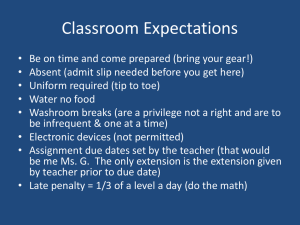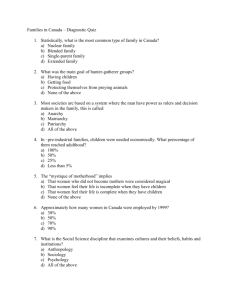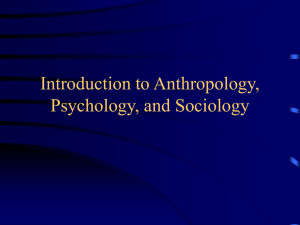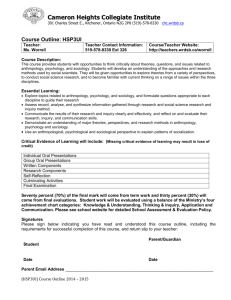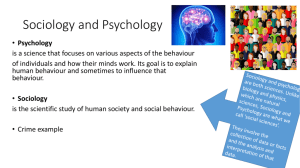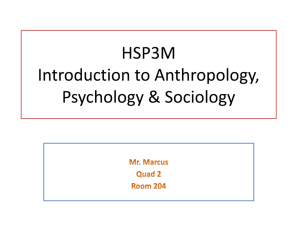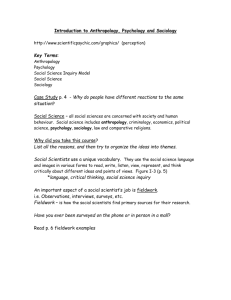1. Intro to Social Sciences PPT - Mrs. Helmer
advertisement
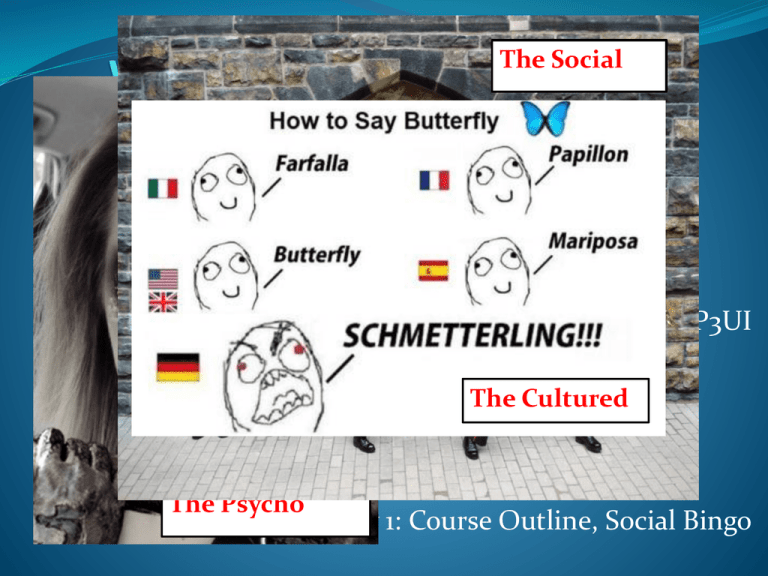
The Social HSP3UI The Cultured The Psycho Day 1: Course Outline, Social Bingo A man walked into a therapist's office looking very depressed. "Doc, you've got to help me. I can't go on like this." "What's the problem?" the doctor inquired. "Well, I'm 35 years old and I still have no luck with the ladies. No matter how hard I try, I just seem to scare them away." "My friend, this is not a serious problem. You just need to work on your self-esteem. Each morning, I want you to get up and run to the bathroom mirror. Tell yourself that you are a good person, a fun person, and an attractive person. But say it with real conviction. Within a week you'll have women buzzing all around you." The man seemed content with this advice and walked out of the office a bit excited. Three weeks later he returned with the same downtrodden expression on his face. "Did my advice not work?" asked the doctor. "It worked alright. For the past several weeks I've enjoyed some of the best moments in my life with the most fabulous looking women." "So, what's your problem?" "I don't have a problem," the man replied. "My wife does." So, you’ve come to the right class! PHS - History and Social Science Department 2013 / 2014 HSP 3MI - Introduction to Anthropology, Psychology and Sociology Teachers: Ms. L. Strong Course Description: This course introduces the theories, questions and issues that are the major concerns of anthropology, psychology and sociology. Students will develop an understanding of the way social scientists approach the topics they study and the research methods they employ. Students will be given opportunities to explore theories from a variety of perspectives and to become familiar with current thinking on a range of issues that have interested social scientists in the three disciplines both in the past and present. Units of Study Each person is simultaneously like no other person, Like some other people, and like all other people. The first part of the course will introduce you to the three different social sciences: Psychology, Sociology and Anthropology. The course will then move into each of the social sciences in more depth. • Introduction to Psychology, Anthropology and Sociology and Research Skills • Psychology: the brain and mental illness • Sociology: socialization, conformity and deviance • Anthropology: culture and multiculturalism in Canada Assessment & Attendance Assessment and Evaluation: 70% Class work, partner and group work, assignments, tests and quizzes, presentations etc. 30% Summative evaluation: Final Exam -10% Major Project -20% Attendance Issues When you are away, the onus is on you to find out what work you have missed, complete the tasks, and come to class with any questions about the work. Tip: find a partner in the class who will collect notes/materials for you and fill you in about missed work. After doing your part, feel free to see your teacher for clarification of anything missed or for extra help. If you miss a test or assignment for a valid reason, you must initiate arrangements to write it. Generally, assume that you will write the test the first day you are back. Due Dates & Late Assignments The following outlines the PHS History and Social Sciences Department policy for the late submission of assignments: All of the Essential Learning in Table 1 (on your outline) must be demonstrated through a variety of methods as described in the Assessment and Evaluation section and must be completed in order to earn this credit. It is also critically important for students to develop good personal management and planning skills. These skills will be reflected in the Learning Skills area of the report card. A presentation date that is missed will receive a mark of zero. In the case of unforeseen absences or illness, the assignment is due on the first day back with proper documentation. See the policy statement in the Student Handbook. Plagiarism Plagiarism is submitting another’s work, writing or ideas as your own.* This occurs when you: • fail to cite sources in an essay or paper carefully and adequately (you will be taught how to avoid this); • intentionally cut and paste an author’s writing from the internet or a book without using quotation marks and citing the source; • submit something written or created by another student or author or; • submit your own essay or written work in two different courses. Plagiarism is a serious academic offence! It will result in an automatic ZERO on the assignment. Please clear up any questions or problems with citation before problems occur! * See the results of the latest (American) National Youth Ethics Survey: http://www2.wnct.com/nct/news/local/education/article/survey_shows_many_teens_lie_cheat_and_steal_their_ way_through_high_school/25233/ Speaking of Cheating… The Josephson Institute in the U.S. has been tracking American youth in regard to their practical ethics. Thousands of high school students are surveyed (12,000 in 2002, 30,000 in 2008). Note the trends. • Students who admitted they cheated on a test/exam in the past year. 1992 2000 2002 2006 2008 61% 71% 74% 60% 64% • Students who admitted they used the Internet to plagiarize. 2006 2008 33% 36% *In my 2009 Gr. 12 Summer School class, 6 of the 15 plagiarized (40%). • Students who admitted they lied to their parents about something significant. 1992 2000 2002 2008 83% 93% 93% 83% What Does it Mean? A few interesting stats: • 26% admitted confessed they lied on at least one or two questions on the survey (Experts agree that dishonesty on surveys usually is an attempt to conceal misconduct) • 93% said they were satisfied with their personal ethics and character • 77% said that when it comes to doing what is right, I am better than most people I know The question is, why do our teens lie, cheat and steal more today? Some experts believe today’s teens “are reacting to intense pressures to achieve and that causes them to cut corners.” Others say the increase in these numbers is more likely “the reflection of a cynical society.” What do you think? Which explanation is ‘psychological,’ and which is more ‘sociological’? Our Classroom Seating Plan -You will have plenty of opportunities in group work to interact with your friends. -While I am leading the class, I find the class can easily be less focused if too many students can easily interact with their neighbours. What Works: Be PREPARED – Come organized for class, with the expectation that You’ll learn something!!! (I know, right?!) PARTICIPATE – Class activities work better when people participate with a positive attitude. (Don’t be lame. I’ll know) Be POLITE – Challenge ideas, don’t attack people. Give those who don’t talk a lot a chance. Psych-Soc-Anthro Bingo Activity Get signatures and identify the correct area from the list below to complete the bingo sheet. Culture Agent of Socialization Genetics Brain Based Birth Order Theory Mental Illness Memory Nature-Nurture Stage of Development Archaeology Bingo Notes Genetics – the process of inheritance – eye colour, twins, family resemblance Brain – memory formation, right/left side dominance, logical/creative Nature/Nurture – second language facility, emotional patterns, musical ability Culture – lived in another country, exposed to different ways of thinking Media Socialization – mass media teaches what we need to know in order to participate in society Agent of Socialization - persons, groups, or institutions that teach us what we need to know in order to participate in society Group Socialization – Harris’s theory – peers more important for personality development (than parents) Birth Order Theory - Adler believed that the order in which you are born to a family inherently effects your personality Stages of Development – Erikson proposed eight stages through which a healthily developing person should pass Archaeology – Cultural Anthropologists rely on the findings of archaeology You, Your Group, Your Culture On a piece of paper: - In the centre put the single most important thing or person in your life - Out from the centre, either draw or write about your: life aspirations, closest friends or family, hobbies, job, school, sports, beliefs, people you admire - add colour Your Notebook Topic(s): I suggest you set up the pages in your notebooks like this. I don’t expect you to record all the info. Main Points Supporting Details • Look for headings • Look for the raw information • You don’t have to write every word Questions/Thoughts * If students make a good effort to keep notes, I will make my PowerPoint notes available on the website! Speaking of Website… “But I HATE websites… why doesn’t Ms. Strong have Twitter?” Add me! It’s not a personal account so please keep all Tweets professional MMMM…. COOKIES!!!!! PICK A PARTNER!!! 1. Partner One, wait out in the Hallway 2. Partner Two, you get to eat an Oreo Cookie! (Partner One will get one once Partner Two has eaten theirs) Test Results Your Personality: 1. The whole thing. This means you consume life with abandon, you are fun to be with, exciting, carefree with some hint of recklessness. You are totally irresponsible. No one should trust you with their children. 2. One bite at a time. You are lucky to be one of the 5.4 billion other people who eat their Oreos this very same way. Just like them, you lack imagination, but that's okay, not to worry, you're normal. 3. Slow and Methodical. You follow the rules. You're very tidy and orderly. You're very meticulous in every detail with every thing you do to the point of being anal retentive and irritating to others. Stay out of the fast lane if you're only going to go the speed limit. 4. Feverous Nibbles. Your boss likes you because you get your work done quickly. You always have a million things to do and never enough time to do them. Mental breakdowns and suicides run in your family. Valium and Ritalin would do you good. Test Results 5. Dunked. Every one likes you because you are always up beat. You like to sugar coat unpleasant experiences and rationalize bad situations into good ones. You are in total denial about the shambles you call a life. You have a propensity towards narcotic addiction. 6. Twisted apart, the inside, and then the cookie. You have a highly curious nature. You take pleasure in breaking things apart to find out how they work, though not always able to put them back together, so you destroy all the evidence of your activities. You deny your involvement when things go wrong. You are a compulsive liar and exhibit deviant, if not criminal, behavior. 7. Twisted apart, the inside, and then toss the cookie. You are good at business and take risk that pay off. You take what you want and throw the rest away. You are greedy, selfish, mean, and lack feelings for others. You should be ashamed of yourself. But that's ok, you don't care, you got yours. 8. Just the cookie, not the inside. You enjoy pain. 9. I just like to lick them, not eat them Stay away from small furry animals and seek professional medical help - immediately. Test Results 10. I don't have a favorite way, I don't like Oreo cookies. You probably come from a rich family, and like to wear nice things, and go to up-scale restaurants. You are particular and fussy about the things you buy, own, and wear. Things have to be just right. You like to be pampered. You are a prima donna. There's just no pleasing you. Psychology, Sociology and Anthropology are sciences that focus on understanding human behaviour. The names are based on Greek or Latin terms: Psychology – Gk. psyche [“spirit” or “soul”] + Gk. logos [“word” or “the study of”] Sociology – Lat. Socius [“companion”] + Gk. Logos Anthropology – Gk. Anthropos [“man”] + Gk. Logos Day 2-3 – Terms, Overview, Cases Individually place terms, then Compare with a partner Key Terms Create a three column chart with the following headings: Psychology Sociology Anthropology Place the following terms in the correct category: Perception Evolution Bystander Effect Natural Selection Chance Mutation Participant Observation Functionalism Institution Cognition Genetics Interventionism DNA Case Study Research Gender Feminism Conflict School Symbolic Interactionism Personality Intelligent Design Theory Survey Research Interview Research Inquiry Model Culture “Missing Link” The Big Three Social Sciences Create an organizer like the following in your notebook. A handout will be provided on the website as well. Psychology Definition: Focus on: Areas of Inquiry: Sociology Anthropology PSYCHOLOGY Definition The scientific study of the mind/psyche Focus On On humans as individual persons On the mental processes, emotions, behaviour and development of the individual to understand the patterns in human behaviour Areas of Inquiry • intense scrutiny of an individual • knowledge of physiology, biology, and current research in sociology Names: Freud, Adler, Jung, Piaget, Skinner, Erikson Example: How does the mind give meaning to what it receives from the senses? How can someone overcome chronic depression? Are our actions or thoughts a result of what is inside us, of what we have been born with, or a result of external influences, of our environment? Is it nature or nurture? Three 20th Century Conceptual Revolutions in Psychology PSYCHOANALYSIS Founded by Sigmund Freud BEHAVIORISM Pioneers: John B. Watson (Founder) B. F. Skinner HUMANISM Pioneers: Abraham Maslow Carl Rogers Distinguishing Between Terms Beginning with the Letters: P S Y C H Psychology: the scientific study of behavior and mental processes. “Scientific” means... beliefs are based on empirical evidence —careful, systematic observations. Psychiatry: the branch of medicine concerned with the diagnosis, treatment, and prevention of mental disorders. Most similar to clinical psychology. Psychotherapy: the treatment of psychological disorders using psychological rather than biological methods. Psychoanalysis: a field introduced by Sigmund Freud consisting of a theory of personality and a method of psychotherapy; emphasizes the unconscious mind. Some Specialty Areas Within Psychology Clinical Psychology: concerned with the diagnosis and treatment of relatively severe mental and behavioral disorders. Counseling Psychology: deals with problems of adjustment in everyday life (marital, social, occupational). Developmental Psychology: focuses on how people change and grow over the lifespan—infancy, childhood (child psychology), adolescence, adulthood, and old age (gerontology). Social Psychology: studies how an individual’s thoughts, feelings, and behavior are affected by other people. Industrial/Organizational Psychology (I/O): focuses on behavior in the workplace. Psychometrics: designs tests to measure mental abilities, personality traits, and symptoms of psychological disorders. SOCIOLOGY Definition: The scientific study of social groups Focus on: On humans as members of a social group On the behaviour of people in groups, on their interactions and relationships and on the social structures they develop Areas of Inquiry: Names: Comte, Durkheim, Marx, Weber, Parsons, Murdock • How the group we belong to shapes our thinking and experience • Relates what appears to be an individual issue (e.g. Suicide) to larger issues (e.g. social alienation) Example: Why do so many North American suffer from depression? Why do increasing numbers of youth cheat at school? Sociology - Theories Conflict Theory - A theoretical framework in which society is viewed as being composed of groups competing for scarce resources. Functional Analysis - A theoretical framework in which society is viewed as a whole unit, composed of interrelated parts, each with a function that, when fulfilled, contributes to society’s equilibrium. Symbolic Interactionism - A theoretical perspective that focuses on how people use symbols to establish meaning, develop their views of the world, and communicate with one another. Anthropology Definition: The scientific study of hominids and human culture over time Focus on: On hominids/humans as members of a species or cultural group On humankind as a species, throughout time; On how human culture has shaped the way people live • Physical Anthropology - compares ancient human/hominid remains using archaeology - compares ancient and modern cultures, looking for Names: patterns Taylor, Boas, • Cultural Anthropology Malinowski, Levi-Straus, - compares shared patterns of learned behaviour in a Lorenz, Leaky, Goodall, particular society with those in another Fosey Areas of Inquiry: Anthropology Primarily concerned with humans as a biological species - Most closely related to natural sciences - Major research areas: Human evolution Modern human variation Subfield of Anthropology, Philosophy, and English Main research areas: - How language is used - Relationship between language and culture - How humans acquire language Sometimes known as Ethnology, Cultural Anthropology examines contemporary societies and cultures throughout the world. Participant observation: Ethnography, ethnographic data Characteristics of a Scientific Approach to Psychology Qualifies its statements about human nature; states the conditions under which a generalization holds up. Quantifies its statements about human nature; uses numbers to describe how much of something there is. Follows rules of evidence to establish facts; key point... We must distinguish between observations (facts) and interpretations (theories). Example: Alternative Parents Observation: Lesbian couples raise happier kids. True/False True A recent study concluded that children raised by lesbians turned out better psychologically than those raised by a “traditional” married couple The study followed children raised by lesbians who were artificially inseminated 25 yrs ago Their children were happier, less aggressive, had less anxiety, and scored higher on “social competence” measures The Jaycee Dugard Case •Read the Article (Handout) •Watch the video news clips of the recent case of Jaycee Dugard. 1) http://youtu.be/0Yppy28Pri I 2) http://www.youtube.com/watc h?v=3cK5XVeenp4 • Record the basic facts of the case (5 Ws) in point form. •In groups, complete the following chart. PSYCHOLOGIST What questions would they ask? What influences would they look to? How would they explain? SOCIOLOGIST ANTHROPOLOGIST Which Questions Does Each Discipline Ask? PSYCHOLOGIST What questions would they ask? What influences would they look to? How would they explain? How did JC react at first? How did her loss lead to parents divorce? How did JC come to sympathize with G.? G.’s home life/parents JC’s coping mechanisms during the early days/months JC’s eventual loyalty is evidence of the ‘Stockholm Syndrome’ SOCIOLOGIST Why did G.’s neighbors not notice? Why was G.on a list of sex offenders? The effect of media attention on JC’s parents. The social rules that kept G.’s neighbors distant. Certain social agreements set up a distance between neighbors. “Nosy neighbor’”= negative ANTHROPOLOGIST Why was the whole community so deeply affected? What value do human communities place on children? Conditions that turn adults against the children of others Other society’s response to pedophilia Our culture sees sex adult-preteen sex as deviant Most cultures have a ‘taboo’ on this Day 3: ‘Common Sense’, Clear Thinking, Proper Inquiry Method, Ethics Common Sense & Human Behaviour ‘Common sense’ defined: Sound judgment not based on specialized knowledge Sound and prudent judgment based on a simple perception of the situation or facts E.g. - What is our common sense understanding of shopping? If we need it and can afford it, we can buy it And if the store has it in stock, we buy it And... Common Sense about Humans Read the following statements. Which do you think are true, and which are false? Violent crime is on the rise in Canada. In terms of personal relationships, opposites attract. Primitive societies have very little technology. Poverty is decreasing in Canada. Capital punishment prevents murders. Children of divorced parents tend to have more problems in school. Homeless people want to be out on the street. Some people dream and some do not. Young people from working-class backgrounds are more likely to commit crimes than those from middle-class backgrounds. 10. Men have always been dominant over women. 1. 2. 3. 4. 5. 6. 7. 8. 9. Every statement is FALSE! Surprised? Why is it difficult to be a good student of humanity simply by watching the news and observing people? Possible answers: • media bias (esp. towards the sensational) • myths/misunderstandings • personal experience skewed by factors such as: age, gender, race, socio-economic background, culture… • personal/common understandings of language Dangers to Clear Thinking Having (and not acknowledging) bias (age bias, gender bias, ethnic, religious, political etc.) Ignoring relevant research ‘Jumping to conclusions’ Relying on a small group/sample for general conclusions Ignoring relevant test/research conditions Mistaking coincidence for cause-effect Relying on faulty/undocumented research Read the short article (Overhead). Identify 5 problems with Rushton’s research. Problems with J. Phillipe Rushton’s Evolution and Behaviour Based on re-analysis of old data Selective use of data – i.e. Only the data that fit His own research broke some ethical rules Inadequate documentation – no list of references Ignoring relevant test conditions – e.g. malnourished Supports prejudices – dangerous precedents Overall – “lousy science” Day 4: Inquiry Method, Ethics, PSA Question ID, Research Methods Good Science – The Inquiry Method 1. Define the question or problem (May involve initial observation, measurement, or definition of a topic. E.g. Of planets before Newton) E.g. How does a part time job affect high school student grades? 2. Form an hypothesis – a possible answer E.g. The more time a student spends at work, the more the marks suffer. (Inverse relation: Hours increase, Grades decrease) 3. Perform experiment and collect data E.g. Report card results + sample survey for hour of work 4. Analyze the data for patterns E.g. 10-15 hrs grade increase 5. Interpret data and draw conclusions that serve as a starting point for new hypothesis (back to #2) Examples Q1: Do EC activities make a student more stressed? H: Yes – because of the time commitment Exp’t: Survey – students involved in EC – compare grades Q2: Are dog owners gen. happier than cat owners? H: Dog owners gen more happy – dogs more expressive Exp’t – 1. examine behaviours, 2. survey of owners Q3: Are students who lie to parents more prone to lie to teachers? H: Yes- if at home then anywhere. Is there a gap? Exp’t: Simple surveys, Interviews of parents & teachers Examples Q: Do humans feel more sympathy for injured animals than injured humans? H: Humans more sympathy to animals (Cute factor) Exp’t – Street surveys, questions, physiological response measurement Think-Pair-Share Your turn: With a partner, propose a question Form an hypothesis (an answer you might expect to find) Come up with an idea for an experiment that you could use to prove/disprove your hypothesis Share ideas with class Social Science Research Methods Case Studies Repeated observations of the same situation or individual over a period of time Detailed information about one situation Difficult to draw general conclusions from one case Used by all social sciences Participant Observation Done in the field rather than the lab Researchers can observe how people behave in their usual surroundings Researchers observe and talk to subjects and share in their activities Research Methods - cont’d Participant Observation – cont’d Sometimes informants are used (= people from the group with whom researchers develop a close relationship; they help interpret the group’s activities) Used mainly by sociologists and anthropologists Library Research Study, analyze, compare research, statistics etc. Natural/Unstructured Observation Done in the field, without predetermined idea Observe people’s behaviour in normal setting, without interaction Notes describe what people do and say Develops ideas of subjects’ attitude and behaviours Research Methods - cont’d Natural/Structured Observation Same as above, except uses predetermined criteria Sample Survey Written/verbal survey that asks questions of a sample group of people that represents a larger group (re. age, sex, religion) Anonymous responses (no specific identifying info required) Used by sociologists to spot trends Gets info about a larger group without direct contact with the whole group – the results are extrapolated Multiple choice answers – easy to analyze but limited to answers supplied, so depth of response is not great E.g. The General Survey – Ask anyone Needs to be a large sample (min. 1000) to get good info Research Methods - cont’d Respondents first answer a series of questions re. their age, sex, occupation, region, race etc.) E.g. Gallup Pole Sample Survey – cont’d The Focused Survey Ask only those people who meet certain criteria (e.g. under 18, only female, only first-borns) Narrows/Focuses the research Interview Limited group, more in-depth, face-to-face Prepared questions Takes time; hard to collate/summarize the individual answers Research Methods - cont’d Experiment Allows researchers to find connection/correlation between factors “Control group” and Experimental group” Which Research Method? PO = Participant Observation NO = Natural Observation LR = Library Research Q = Questionnaire E = Experiment I = Interview Q Do Americans believe that Obama is living up to his promise as ____ President of the U.S.? NO Does the presence of an adult influence social behaviour in a ____ school playground? ____ PO What is the lifestyle of the new Canadian immigrant from South America? ____ I What are the social concerns of expectant mothers in Canada today? L How has the number of common-law marriages changed since ____ 1950? ____ E Are employers more likely to hire someone who is taller than average? Day 5-6: Surveys, Questions, Stats, Ethics Research Methods: Surveys – Good, Bad, and Ugly The Good – Surveys can be very useful, and revealing! The Bad – Survey information lacks depth, so questions must be carefully worded. The Ugly – A survey reports that 80% of students want homework on Saturdays! Does this seem likely? The question was: WHICH would you prefer to do on Saturdays: (a) homework, (b) go to school Imprecise questions and poorly developed choices can create unreliable and even unbelievable results! The Sample Survey - Questions Sample surveys are often used by institutions (School Bullying Survey), business (brand recognition), and governments. It targets a group of people that can represent a larger group Results are extended (extrapolated) to apply to the whole group Multiple choice answers provide data that is easy to analyze Problem – information is limited to the choices, and lacks depth Examples: Anything missing? What is your major source of news? a) radio b) TV c) newspaper How often have you engaged in physical exercise in the last week? a) once b) twice c) three times d) four or more times The Sample Survey - Questions Examples – cont’d Overall, I really enjoy working cooperatively with other students. a) Strongly disagree b) Disagree c) Undecided d) Agree e) Strongly agree Cooperative learning has helped me understand course materials. a) Strongly disagree b) Disagree c) Undecided d) Agree e) Strongly agree What do you like most about group work/assignments? _____________________ Refer to the examples above and answer the following: 1. What are closed-ended questions? 2. What are open ended questions? 3. What are two advantages and two disadvantages to using sample surveys? 4. When is it best to use a sample survey? Why? Sample Survey - Questions Question bias – Word Choice Word choice can bias a survey by choosing words that influence a respondent's answer. The following asks essentially the same question, but influenced the response in opposite directions: Do you support cutting programs involving aid to the needy? ----- Do you support cutting public welfare programs?----- 10% 39% Other sources of bias: Non-response – Missing data – big problem in phone surveys Don’t know/Undecided – May be used to ‘flatter’ the preferred response Ignorance – From respondents who do not wish to appear ignorant Timing – E.g. Football as nation’s favourite sport - in a January survey Under-coverage – survey sample not representative of target population Sample Survey - Questions Untruthful answers – Reasons: sensitive questions, socially unacceptable answers, telling surveyor what s/he wants to hear. – E.g. In an experiment, 58% told a phone surveyor that they exercised regularly, but in a private online survey the number was 35% [regular church attendance: 56% over the phone, but 25% on line] “Leading the witness” – Surveys can lead the respondent to give the desired results - E.g. One survey focused on the bottled water industry and its impact on life, environment and economies. A survey was used to measure people’s perceptions and opinions. Examine the questions and try to identify where the survey is ‘leading the witness’ Can anyone give me an example of where they have read a survey question in the past that was biased? Surveys See Any Problems? 14. Do you believe that water can be more expensive than oil? This question ‘gives away the game.’ It doesn’t measure perceptions, and reveals what the surveyor is after. An Alternative? 14. For each of the following, compare your expectation of its price to water: a) Much more costly b) More costly c) Same d) Cheaper e) Much cheaper gasoline coca-cola shampoo orange juice Surveys See Any Problems? The question must not reveal the intention of the surveyor. And it must not (as the last 3 questions do) put the person on the defensive, implying that they should be doing something in a certain way. See the handout... Survey Assignment Work with a partner (or by yourself) Formulate a Social Sciences question/problem A question about human behaviour One that can be explored using a Sample Survey Develop your hypothesis (tentative answer) Run it past your teacher Develop 20 relevant, unbiased questions Write a paragraph explaining your reasoning See the assignment handout Due in 1 week! TUESDAY! Day 7-8: Structured Observation Interview, Analyzing Survey Results Research Methods: Unstructured Observation Observer attempts to describe relevant behaviour Descriptive notes are taken during the observation This is called Qualitative data – e.g. A qualitative way to report room temperature: the room is warmer than the outside; quantitative: room temperature is 23 degrees C *** Unstructured Observation Activity *** With 1-2 partners, find a location in the school NB: NOT outside, in any classroom, the library (Admin. knows) – Do not disturb any class Record observations about people you see in your location Return to class after 15 minutes Unstructured Observation – The Data Use the descriptive data gathered Create a checklist of specific behaviours Would be used in Structured Observation Must be specific behaviours Behaviours must be a meaningful part of the activity described in your notes Some interpretation required Count the number of boys and girls in each class. Research Methods: Structured Observation Can take several forms; most common is the checklist Behaviours recorded during unstructured observation can be used to create the checklist Behaviours must be explicitly defined so that there is no question in the mind of the observer as to whether or not they occur. Advantage: 1) many more subjects can be observed, in less time, than with unstructured observation, 2) data analysis is much simpler – count how many times the behaviour occurred Exercise: With your partner, examine your unstructured observations and develop a list of specific behaviours to observe - RE-EVALUATE! Go back out into a different classroom to gather quantitative data! Results of In-Class Structured Observation 2012 Off Task Behaviours Incidences - Boys Incidences - Girls Inattentive 6 2 2 3 =13 3012 Disruptive 2 3 3 4 1 11 =24 001002 Inappropriate Comment 1 2 4 6=13 0001 Talking Out 11 0 7 1 4 1 12 = 5121743 Talking with Peer(s) 8 3 8 5 3 11 15 5118038 Texting 2912411 3 0 1 15 5 6 5 Uncooperative 0062 0000 Uninvolved 14542 00811 Using Materials Inappropriately 05 30 Analyzing the Data: Statistics The raw data collected can be organized in a variety of ways E.g. – Total number of incidences (of B&G or Bs or Gs) E.g. - Find Median, Average E.g. - Find Total or Mean or Average of a specific behaviour Total Incidences of Off Task Behaviours B&G: B: G: # 0f classes: # of classes: # of classes: Median – __________ B&G: B: G: B&G: B: G: (1. List #’s 2. Find middle) Average (Mean) What patterns emerge from the Data? E.g. How do boys and girls behaviour patterns compare/contrast? Results of In-Class Structured Observation 2012 Off Task Behaviours Incidences - Boys Incidences - Girls Inattentive 5+9+8+1+7+1+6 = 36 1+6+5+8+7+2 =29 Disruptive 13 +18+ 2+3+2+5 = 43 Inappropriate Comment 2+3+2+2+7+4+4 = 24 1+2+1+2 +20 = 26 Talking Out 7+4 +22 +5+3+5 = 46 1+2+4+5+1+6 = 19 Talking with Peer(s) 27+ 15+ 30+ 8+ 11 +17 16+ 5= 129 16 +13 +19 +12+ 12+ 15 22 +9 = 106 Texting 2+7+2+ 17 +2+ 3 = 33 4+3+4+ 23 6 7 5 = 52 Uncooperative 2+5+1+5+1+1 = 15 1+3+1+2 = 7 Uninvolved 2+6+2+2+7+3+3 = 25 3+1+2+2+3+1+2 = 14 Using Materials Inappropriately 1+2+5+7+1 = 16 1+2 +14 =17 4+4+25+6+3 = 42 Analyzing the Data: Statistics The raw data collected can be organized in a variety of ways E.g. – Total number of incidences (of B&G or Bs or Gs) E.g. Find Median, Average E.g. Find Total or Mean or Average of a specific behaviour Total Incidences of Off B&G: 679 Task Behaviours # classes: 8 total B: 367 G: 312 Median – Talking w. B&G: 15 B: 15-16 G: 13-15 B&G: 15.4 B: 16 G: 14.7 Peers Average (Mean) What patterns emerge from the Data? E.g. How do boys and girls behaviour patterns compare/contrast? Results: Off Task Behaviour After collecting the data, it can be ‘worked’ in a number of ways E.g. Bar graphs can give a visual representation In which off task behaviour do boys and girls differ the most (in our data sample)? Research Methods: Interview Typically involves a face-to-face meeting in which a researcher (interviewer) asks an individual a series of questions Questions are prepared, but others can be asked as needed Responses are recorded/transcribed exactly NB: permission for the interview, participant aware of the purpose and intended audience of the interview E.g. We are conducting an experiment on teenage behaviour… It’s an assignment for our Psychology Unit. Activity (20 minutes) Partners – develop 5 basic questions to ask students in halls Find 5 students in halls – Ask other questions as needed Use the checklist provided to gather profile/interview info Record specific terms used by subjects (as needed) Day 9-11: Structured Observation Analyzing Survey Results, Participant Observation “Instinct” – Types of Observation Look over your notes: Which research methods are used by the two main characters in the film: Gooding’s character: Interview Hopkin’s character: Participant Observation Read about the case of Chagnon and a primitive people called the Yanomamo. Answer questions in your notebooks You may highlight or write on the reading READING QUESTIONS Who is Chagnon? What are his qualifications? What did he study? What were his conclusions? How had anthropology “changed” over the years? What were the implications of this change on Chagnon’s research? How did Tierney’s Darkness in El Dorado view Chagnon’s findings? What have you concluded about Participant Observation from this article? Participant Observation Go to your notes for a basic definition of PO Reading: The Case of Chagnon and the Yanomamo 1968 – Yanomamo: The Fierce people by Napoleon Chagnon Culture featured much male violence Wife beating common, men tried to provoke each other 30% of men die violently – fighting mostly over women Polygamy – where a man has several wives + shortage of women Female abduction common Reputation for fierceness made it easier to attract/keep wives Men regarded as killers had more wives Chagnon’s book became one of the most widely read cultural anthropology books of all time – Q: Were the killers genetically selected or was it a cultural adaptation to their environment? Participant Observation 2000 - Patrick Tierney, Darkness in El Dorado Concluded that journalists, scientists, anthropologists who studied the Yanomami had not merely observed the violence, but triggered it!! Major disaster – measles carried into the area Chagnon arranged to inoculate the Yanomami – but genetically isolated people are prone to severe inoculation-related fevers Worst epidemic broke out – killing hundreds Tierney charged that Chagnon knew the dangers, and went ahead anyway to see if the dominant males would survive at a greater rate – This would answer his question! Tierney’s charge is unproven... Q: Why is this whole study so controversial? Who do we believe? Participant Observation Professional responsibility as a researcher: Informed consent Clear communication Assessment of positive and negative effects Day 12-13 – Case Studies Experiment A special observation made to confirm or disprove something the only means by which cause and effect can be established Allows for control of variables: isolate the one key variable which has been selected (the Independent Variable), in order to observe its effect on some other variable (the Dependent Variable) can be replicated, gives quantitative data (numerical amounts of something) which can be analysed But – it can be Artificial - The experiment is not typical of real life situations The range of behaviour in a lab is very limited There are cues in the experiment that convey to the participant the purpose of the experiment (called: demand characteristics) Experiment – Example Memory Experiment In groups of 3: Facilitator, Recorder and Subject Facilitator reads a list of words to the subject After the list has been read, the subject writes down as many words as s/he can remember The Recorder checks off the number of terms correctly remembered in the tabulation chart provided Repeat this procedure for the second list of terms The group discusses and tries to explain the difference in the subject’s performance The process is repeated for List #3 The group discusses the difference in the difficulty between List #1, 2 and 3 Experiment – Example Lost letter experiment Milgram developed a technique for measuring how helpful people are to strangers who are not present, and their attitudes toward various groups, called the "lost letter" experiment. Several sealed and stamped letters are planted in public places, addressed to various entities, such as individuals, favourable organizations like medical research institutes, and stigmatized organizations such as "Friends of the Nazi Party". Milgram found most of the letters addressed to individuals and favourable organizations were mailed, while most of those addressed to stigmatized organizations were not. Case Study Repeated observations of the same situation or individual over a period of time Provides a lot of detailed information about one person or situation Therefore – it is difficult to draw general conclusions Used by all three social sciences A case study is made up of: Background Info - age, gender, work, health status, family mental health history, family and social relationships, drug & alcohol history, life difficulties, goals & coping skills & weaknesses Description of the Presenting Problem – Describe problem or symptoms; any physical, emotional, sensory symptoms reported by the subject; and any of his/her thoughts or feelings Diagnosis – Summarize the two or more possible treatment approaches The Case of David Presenting Problem In trouble with law (arrest, in youth jail) Theft Assault – violence, anger Self control is an issue Background Angry as a child – lack of discipline Lack of support at hope – teasing during potty training Some destructive tendencies as small child Fights at middle school Social skills an issue – friends are few Lack of support at school – Gr 5 teacher Substance abuse Sibling tensions with older sister Dog’s death = trigger of ‘low mood’ Patterns: Aggression Authority issues Increasing destructive behaviour Illegal activity increasing Diagnosis ADHD? – energy as child, talk, bounding, inflexibility, agitated Parenting – inconsistent discipline Sibling relationship an issue – source of attention seeking Autism? – High IQ – exceptional in one area – distracted Needs to develop emotional control skills, coping skills Need for support indicated at home Need for structure indicated -Binder check? -PowerPoint availability PSYCHOLOGY Definition The scientific study of the mind/psyche Focus On On humans as individual persons On the mental processes, emotions, behaviour and development of the individual to understand the patterns in human behaviour Areas of Inquiry • intense scrutiny of an individual • knowledge of physiology, biology, and current research in sociology Names: Freud, Adler, Jung, Piaget, Skinner, Erikson Example: How does the mind give meaning to what it receives from the senses? How can someone overcome chronic depression? Are our actions or thoughts a result of what is inside us, of what we have been born with, or a result of external influences, of our environment? Is it nature or nurture? SOCIOLOGY Definition: The scientific study of social groups Focus on: On humans as members of a social group On the behaviour of people in groups, on their interactions and relationships and on the social structures they develop Areas of Inquiry: Names: Comte, Durkheim, Marx, Weber, Parsons, Murdock • How the group we belong to shapes our thinking and experience • Relates what appears to be an individual issue (e.g. Suicide) to larger issues (e.g. social alienation) Example: Why do so many North American suffer from depression? Why do increasing numbers of youth cheat at school? Anthropology Definition: The scientific study of hominids and human culture over time Focus on: On hominids/humans as members of a species or cultural group On humankind as a species, throughout time; On how human culture has shaped the way people live • Physical Anthropology - compares ancient human/hominid remains using archaeology - compares ancient and modern cultures, looking for Names: patterns Taylor, Boas, • Cultural Anthropology Malinowski, Levi-Straus, - compares shared patterns of learned behaviour in a Lorenz, Leaky, Goodall, particular society with those in another Fosey Areas of Inquiry: Dangers to Clear Thinking Having (and not acknowledging) ______ (re. age, gender, ethnic, religious, political etc.) Ignoring relevant __________ ‘Jumping to conclusions’ Relying on a small ____________ for general conclusions Ignoring relevant test/research conditions Mistaking coincidence for cause-effect Relying on faulty/undocumented research Problems with J. Phillipe Rushton’s Evolution and Behaviour Based on re-analysis of old data Selective use of data – i.e. Only the data that fit His own research broke some ethical rules Inadequate documentation – no list of references Ignoring relevant test conditions – e.g. Malnourished Supports prejudices – dangerous precedents Overall – “lousy science” Good Science – The Inquiry Method 1. Define the ________________________ (May involve initial observation, measurement, or definition of a topic. E.g. Of planets before Newton) E.g. How does a part time job affect high school student grades? 2. Form an __________________ – a possible answer E.g. The more time a student spends at work, the more the marks suffer. (Inverse relation: Hours increase, Grades decrease) 3. Perform experiment and collect data E.g. Report card results + sample survey for hour of work 4. Analyze the data for ______________ E.g. 10-15 hrs grade increase 5. Interpret data and draw conclusions that serve as a starting point for new hypothesis (back to #2) Social Science Research Methods Case Studies Repeated observations of the ____________________ over a period of time Detailed information about __________ situation Difficult to draw ____________________ from one case Used by all social sciences Participant Observation Done in ________ rather than the lab Researchers can observe how people behave in ______________ surroundings Researchers observe and talk to subjects and share in their activities Library Research Study, analyze, compare research, statistics etc. Research Methods - cont’d Participant Observation – cont’d Sometimes informants are used (= people from the group with whom researchers develop a close relationship; they help interpret the group’s activities) Used mainly by ____________ and ______________ Natural/Unstructured Observation Done in the field, without predetermined idea Observe people’s behaviour in normal setting, without interaction Notes describe what people do and say Develops ideas of subjects’ attitude and behaviours Natural/Structured Observation Same as above, except uses predetermined criteria Research Methods - cont’d Sample Survey The Focused Survey Ask only those people who meet certain criteria (e.g. under 18, only female, only first-borns) Narrows/Focuses the research Interview Limited group, more in-depth, face-to-face Prepared questions Takes time; hard to collate/summarize the individual answers Experiment Allows researchers to find connection/correlation between factors “Control group” and Experimental group” Which Research Method? PO = Participant Observation NO = Natural Observation LR = Library Research Q = Questionnaire E = Experiment I = Interview Q Do Americans believe that Obama is living up to his promise as ____ President of the U.S.? NO Does the presence of an adult influence social behaviour in a ____ school playground? ____ PO What is the lifestyle of the new Canadian immigrant from South America? ____ I What are the social concerns of expectant mothers in Canada today? L How has the number of common-law marriages changed since ____ 1950? ____ E Are employers more likely to hire someone who is taller than average?
